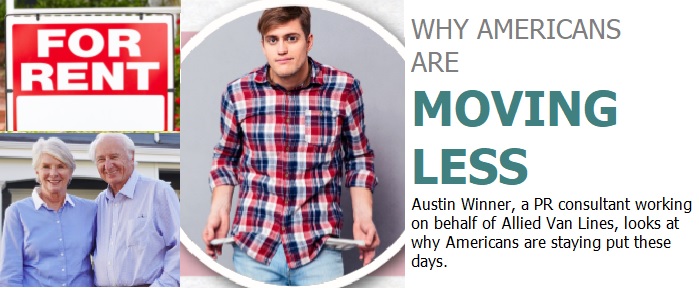Austin Winner, a PR consultant working on behalf of Allied Van Lines, looks at why Americans are staying put these days.

According to a study, only 10.1% of Americans moved homes between August 2017 and August 2018. These moving levels are at record lows according to US Census records that began tracking this data in 1948 when Americans were moving at a rate of 20.2%. There are a number of explanations.
Limited supply of housing
A significant amount of homes are currently being bought with the intent of using the property as a rental. This has negatively impacted the inventory of houses available for sale. Slate reports that about 3% of the homes in the US were purchased by landlords as investment properties.
The shortage of homes is also attributable to fewer homes being built. Lower construction rates are partially blamed on factors such as more land use restrictions, a scarcity of vacant lots, the high cost of building materials, and a shortage of skilled workers. The demand for new homes in many larger cities is far greater than the supply.
The ageing population
The population is ageing. Older people tend to be homeowners. The reason this matters is because older people tend to stay in their homes. Baby Boomers are such a large percentage of the population that they are dragging down the moving averages.
Stagnant income
While the older generation is partly to blame for lower levels of mobility today, young people also contribute to this societal change. Stagnant income makes it difficult for younger adults to get established. Slate reports that only 24% of young people between the ages of 20 and 24 moved last year; that’s a full ten percentage points lower than it was in 1996.
Slate also reports that median income for younger adults has increased a mere 5% over the past 30 years, which explains why younger adults can't afford to move. When you add that to the financial loan crisis facing young adults, it explains why they’re having trouble buying their first houses. At the very least, they’re having to remain diligent in saving money to be able to afford a move.
Lower rates of job creation in favour of a Gig Economy
First, there are significant increases in the number of telecommuting or remote workers who don't have to necessarily live in the city where their employer resides. Contract workers have no guarantees and typically have to pay for their own health insurance. With fewer permanent jobs and more contract workers being hired, it is no surprise that workers are reluctant to move.
Homeownership subsidies
Government subsidies that reward homeowners via tax credits serve to discourage moving. CityLab reports that only 5% of homeowners decided to pick up and move as compared to 9.5% in the year 1988. Many politicians are calling for a stop to these government subsidies.
Occupational licensing
Many jobs require state licensing that is not transferrable. Lawyers, doctors, and real estate agents are just a few of the professions that come to mind as professionals who must be licensed. CityLab reports that as of 2008 records, 25% of the workforce is licensed as compared to only 5% in the 1950s.
There are other issues, of course. Financial literacy is a growing issue in America - and there’s no course in schools that teaches students about PMI (Private Mortgage Insurance). More simply, the motivation for moving has drastically changed. The perfect storm of changes in the way Americans work has come together with current market conditions to discourage mobility. Occupational licensing, stagnant income growth and unaffordable housing make it difficult for workers to move. Additionally, the large Boomer population isn't going anywhere as they continue to retire in record numbers.
Photo: Austin Winner